
Illustration of A. baumannii bacteria. Image: Medical illustrators Dan Higgins and James Archer/CDC
At a glance:
- Revealing the inner workings of drug-resistant bacteria is informing development of much-needed new antibiotics.
- Experimental drug now in clinical trials takes a new approach to defeating deadly A. baumannii infections.
- Collaboration between basic research scientists and the pharmaceutical industry drove the advances.
Harvard University chemist Daniel Kahne has spent much of his career studying the fundamentals of how bacteria thrive and evade attack.
His lab has a special interest in gram-negative bacteria, which have an outer membrane that many antibiotics cannot cross.
Among these bacteria is carbapenem-resistant Acinetobacter baumannii, or CRAB. Designated by the World Health Organization as a “critical priority” for antibiotic development, CRAB kills hundreds of critically ill patients in the U.S. each year, usually in hospital settings, by causing untreatable blood, lung, or urinary tract infections.
Strengthened by partnerships with basic research labs and the pharmaceutical industry, Kahne and colleagues are working to usher in a new class of antibiotics to combat the A. baumannii superbug — and perhaps others.
Such an achievement would have significant benefit for human health. No new antibiotics have been introduced for gram-negative bacteria in more than 50 years, and the WHO has declared that development of new antibiotics remains “inadequate” to address the global threat of antibiotic resistance.

We are starting to have a fairly deep understanding of how many of these molecular machines work. I think that’s going to be incredibly helpful in designing next-generation antibiotics.
Andrew Kruse




